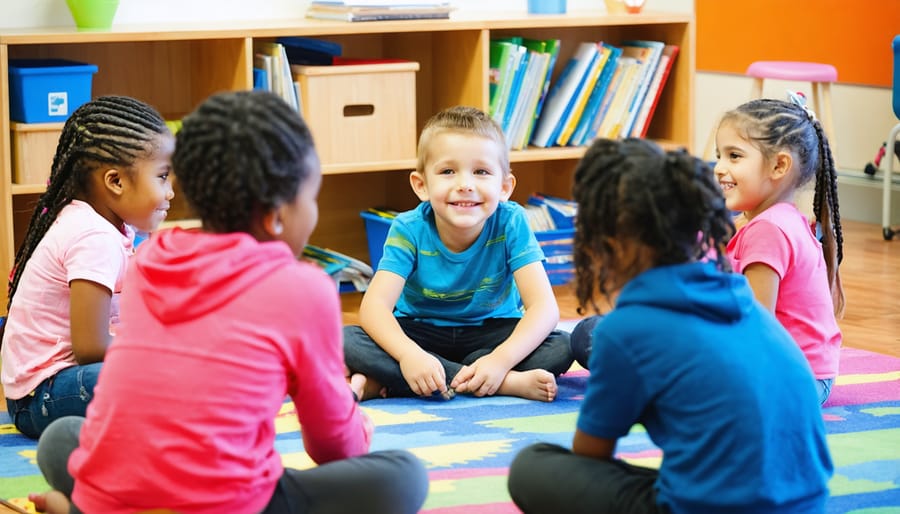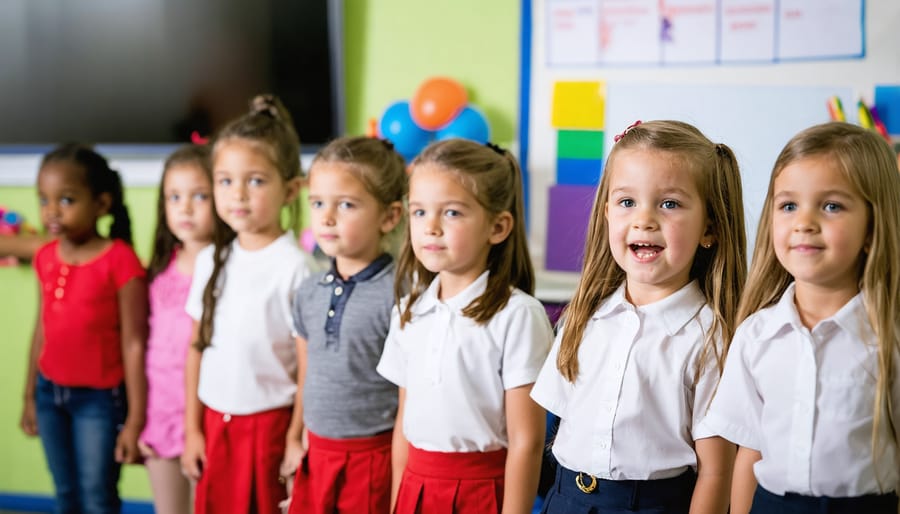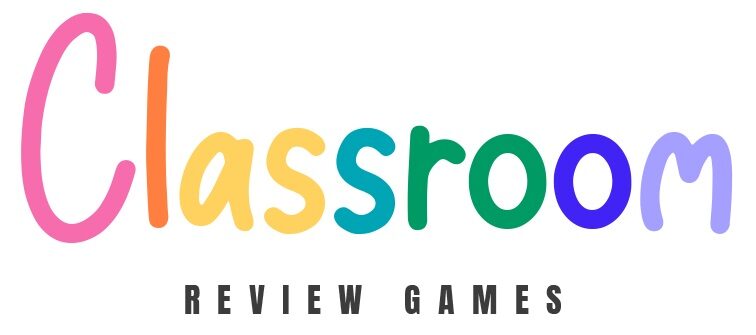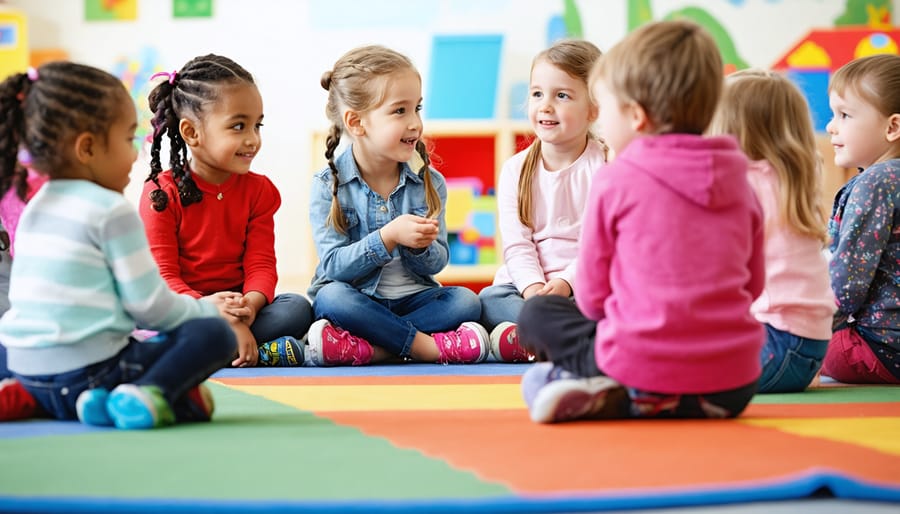Make Classroom Rules Fun: How Students Create Their Own Success
Transform your kindergarten classroom into a positive learning space by establishing clear, age-appropriate rules through interactive methods that engage young learners. Create colorful visual aids with simple pictures and words that illustrate each rule, making them easier for children to understand and remember. Get students actively involved in the rule-making process by turning it into a guided discussion where they share ideas about what makes their classroom safe and fun.
Instead of presenting rules as restrictions, frame them as opportunities to be classroom heroes – helping friends, using kind words, and taking care of shared spaces. Reinforce positive behavior through immediate praise, sticker charts, and simple reward systems that celebrate when children follow the rules successfully. Keep the total number of rules between 3-5, using clear language like “walking feet” instead of “no running” to focus on desired actions rather than restrictions.
This foundation of clear expectations, paired with consistent positive reinforcement, creates a structured environment where young learners can thrive while developing crucial social and emotional skills.
Why Interactive Rule-Setting Works in Kindergarten
Building Ownership and Understanding
When students actively participate in creating classroom rules, they’re more likely to follow them! Let kids contribute their ideas during a class discussion, asking them what they think makes a happy, safe classroom. You’ll be amazed at how many important rules they’ll suggest themselves.
Turn rule-making into an engaging activity by having students draw pictures of good classroom behavior or act out scenarios. This hands-on approach helps young learners understand why each rule matters. When a child suggests “using quiet voices,” ask them to explain why it’s important – they might say it helps friends concentrate better!
Create a colorful rule chart together, using both words and pictures. Let students add their handprints or signatures next to the rules as a special “promise” to follow them. This ownership makes rules feel less like restrictions and more like agreements they helped create, leading to better compliance and a more positive classroom environment.
Creating a Positive Classroom Culture
Creating a positive classroom culture through well-established rules helps boost student engagement and fosters meaningful relationships among kindergarteners. When children understand and follow classroom rules together, they develop a sense of community and shared responsibility. This collaborative environment encourages students to support one another, celebrate successes, and work through challenges as a team.
Fun rules and consistent positive reinforcement create a safe space where children feel confident expressing themselves and taking learning risks. You’ll notice students becoming more empathetic, helping peers remember rules, and showing pride in their classroom community. This positive atmosphere makes learning more enjoyable and helps children develop crucial social-emotional skills they’ll carry throughout their education journey.
Remember to celebrate when students follow rules successfully – their excitement is contagious and strengthens the supportive classroom culture you’re building!

Fun Activities for Creating Classroom Rules
Rule-Making Theater
Transform your classroom into a mini-theater where students actively participate in rule-learning scenarios! Start by having children act out common classroom situations – both following and breaking rules. For example, one student can demonstrate walking quietly to their seat while another shows running in the classroom.
Create simple skits where students take turns being the “rule helper” who spots and corrects inappropriate behavior. You can use puppets for shy students who might feel more comfortable performing through a character. Make it fun by adding simple props like a “quiet walking shoes” or a “helping hands” glove.
Encourage discussion after each performance by asking questions like “What rule did we see?” and “Why is this rule important?” Let students suggest alternative scenarios and solutions. You can even turn these role-playing sessions into a weekly activity where children earn special “Rule Star” badges for participating.
Remember to keep scenarios age-appropriate and positive, focusing more on demonstrating good behavior rather than emphasizing mistakes. This hands-on approach helps children internalize rules while having fun!

Picture Perfect Rules
Visual aids are a fantastic way to help young learners understand and remember classroom rules. Create colorful posters featuring simple drawings that illustrate each rule in action. For example, draw happy children sitting quietly in a circle for “listening ears,” or show kids washing their hands for “clean and healthy habits.” Include both positive examples and gentle “not to do” illustrations to make expectations crystal clear.
Get your students involved by having them help create these visual rule reminders. Let them draw pictures showing what following each rule looks like, then display their artwork prominently around the classroom. This ownership helps children feel more connected to the rules and more likely to follow them.
Consider using a combination of photos and drawings, featuring actual classroom moments when students demonstrate good rule-following behavior. Update these displays throughout the year to keep them fresh and relevant to current classroom activities and challenges.
The Rules Song Game
Music has a magical way of helping children remember important information, and classroom rules are no exception! Create simple, catchy tunes using familiar melodies like “Twinkle, Twinkle Little Star” or “Mary Had a Little Lamb” to teach classroom rules. For example, sing “Walking feet inside the room, gentle hands with friends all day, listening ears when teachers say, this is how we learn and play!” Get creative and involve your students in writing the lyrics – they’ll love contributing their ideas and are more likely to remember rules they helped create.
Add simple hand motions or movements to reinforce each rule as you sing. For instance, tip-toe during “walking feet” or cup hands behind ears for “listening ears.” Practice the song daily during morning circle time or transition periods. Soon you’ll notice children humming the tune and reminding each other of the rules through song. This musical approach makes learning classroom expectations fun and memorable for young learners.
Implementing and Reinforcing Rules Through Games
Weekly Rule Stars
Make rule-following exciting with our “Weekly Rule Stars” recognition system! This engaging approach combines positive reinforcement techniques with a fun, visual tracking method that kindergarteners love.
Create a colorful star chart with each student’s name and display it prominently in your classroom. Throughout the week, award gold stars when students follow classroom rules consistently. For example, give stars for walking quietly in line, using indoor voices, or cleaning up after activities.
At the end of each week, celebrate your Rule Stars! Students who collect five stars earn special privileges like being line leader, choosing a favorite story for storytime, or wearing a special “Rule Star” badge. Consider implementing different star colors for various rules – blue for quiet time, green for cleanup, and gold for exceptional behavior.
Make it extra special by sending home “Rule Star of the Week” certificates to share successes with families. This creates a positive home-school connection and reinforces good behavior. Remember to keep the system simple and achievable – every student should have the opportunity to shine as a Rule Star!
To maintain excitement, rotate special privileges monthly and occasionally surprise your Rule Stars with small rewards like stickers or extra playground time. This system helps students internalize rules while making the learning process fun and rewarding.

Rule Review Games
Make learning rules fun and memorable with these engaging review games that kindergarteners love! Start with “Rule Charades,” where students act out classroom rules while others guess. This gets everyone moving and giggling while reinforcing proper behaviors.
“Simon Says Rules” puts a creative spin on the classic game. Instead of basic actions, use rule-related commands like “Simon says show me walking feet” or “Simon says demonstrate quiet voices.” Students who follow the rules correctly stay in the game.
Create a “Rules Superhero” game where children earn special badges for demonstrating good rule-following throughout the day. When they collect all badges, they become the class Rules Superhero and help remind others about expectations.
Try “Red Light, Green Light Rules” – call out a rule, and if it’s a good behavior, students move forward. If it’s something they shouldn’t do, they stay still. This combines physical activity with rule recognition.
“Musical Rules” works like musical chairs, but when the music stops, pull out a picture card showing a classroom rule. Students take turns explaining the rule and why it’s important.
Remember to keep these games short, upbeat, and frequent. Offer simple rewards like stickers or extra playtime to maintain enthusiasm. Switch up the games regularly to keep students engaged and excited about following classroom rules.
Troubleshooting Common Challenges
Even with the best-planned rule-setting activities, you might encounter some bumps along the way. Don’t worry – these challenges are completely normal! Here are simple solutions to common issues you might face:
When students struggle to remember rules, try turning them into catchy songs or rhymes. For example, “Hands to ourselves, voices low, this is how we learn and grow!” Visual cues like pictures or hand signals can also help reinforce rules without constant verbal reminders.
If you notice some students aren’t participating in rule discussions, try using puppet shows or role-playing activities to make the process more engaging. This helps shy students feel more comfortable sharing their thoughts through characters rather than directly.
When rules are repeatedly broken, avoid getting frustrated. Instead, create a “rule review” game where students earn points for following rules correctly. You might notice some students becoming “rule police” – gently redirect this behavior by making them “helping heroes” who show others the right way rather than pointing out mistakes.
For students who have trouble transitioning between activities, use visual timers and give “five-minute warnings” with a special song or chime. This helps them prepare for changes while staying within the rules.
Remember, consistency is key! If you need to adjust rules, involve students in the process to maintain their sense of ownership and understanding.
Creating and maintaining effective classroom rules in kindergarten doesn’t have to be complicated. By involving your students in the rule-making process, using visual aids, and making it fun through games and songs, you’ll build a positive learning environment that works for everyone. Remember to stay consistent with enforcement while keeping a gentle, encouraging approach. Celebrate when students follow the rules and use teachable moments when they don’t. With these strategies in place, you’ll foster a classroom community where young learners feel safe, respected, and excited to participate. Start small, be patient, and watch as your kindergarteners grow into responsible, engaged learners who understand and value the importance of classroom rules.


